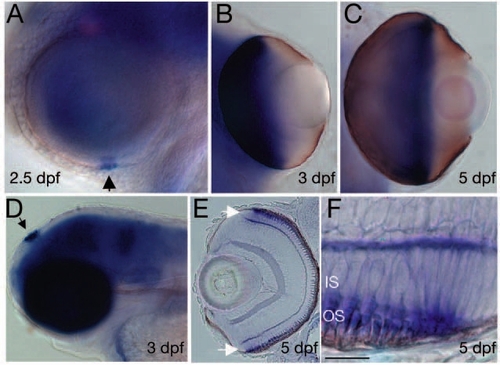- Title
-
Duplicated genes with split functions: independent roles of protocadherin15 orthologues in zebrafish hearing and vision
- Authors
- Seiler, C., Finger-Baier, K.C., Rinner, O., Makhankov, Y.V., Schwarz, H., Neuhauss, S.C., and Nicolson, T.
- Source
- Full text @ Development
|
Expression pattern of pcdh15a using in situ hybridization. (A-E) pcdh15a expression in embryos and larvae. At the four-somite stage (A), pcdh15a is expressed in the anterior neuroectoderm and in the somites. At 24 hpf (B), there is expression in the eye, the hatching gland (blue shading under the eye, out of focus) and the first hair cells of the ear at the margins of the otic vesicle (arrowhead and panel C). At 3 dpf (D), expression of pcdh15a is not detectable in the eye, whereas expression is present in the ear (asterisk), the brain and the lateral parts of the epiphysis (arrowheads). At 4 dpf (E), expression is present in the hair cells of the ear (arrows indicate the posterior maculae present in this focal plane) and the neuromasts (arrowheads). (F) Higher magnification view of the pcdh15a-positive hair cells of the anterior macula. (F′) Higher magnification view of a trunk neuromast. Scale bar in F′: 180 µm for A,B; 50 µm for C; 120 µm for D; 150 µm for E; 30 µm for F; 20 µm for F′. EXPRESSION / LABELING:
|
|
Temporal expression pattern of pcdh15b in differentiating photoreceptor cells. (A) At 2.5 dpf, pcdh15b is expressed in the first differentiating photoreceptors at the ventral margin of the eye (arrowhead). (B) At 3 dpf, the whole proximal optic cup is stained. (C) At 5 dpf, expression is only present at the margin of the optic cup, no expression is visible in the proximal eye. (D) Expression in the epiphysis (arrow) and brain at 3 dpf. pcdh15b expression in the eye is specific to photoreceptor cells (E,F; cryosection of a larva stained as in C) Arrows in (E) indicate photoreceptor proliferation zones shown at higher magnification in (F). Scale bar in F, 50 µm for A; 40 µm for B,C,E; 150 µm for D; and 5 µm for F. IS, inner segment; OS, outer segment. |

Unillustrated author statements |


